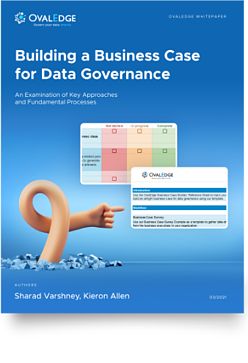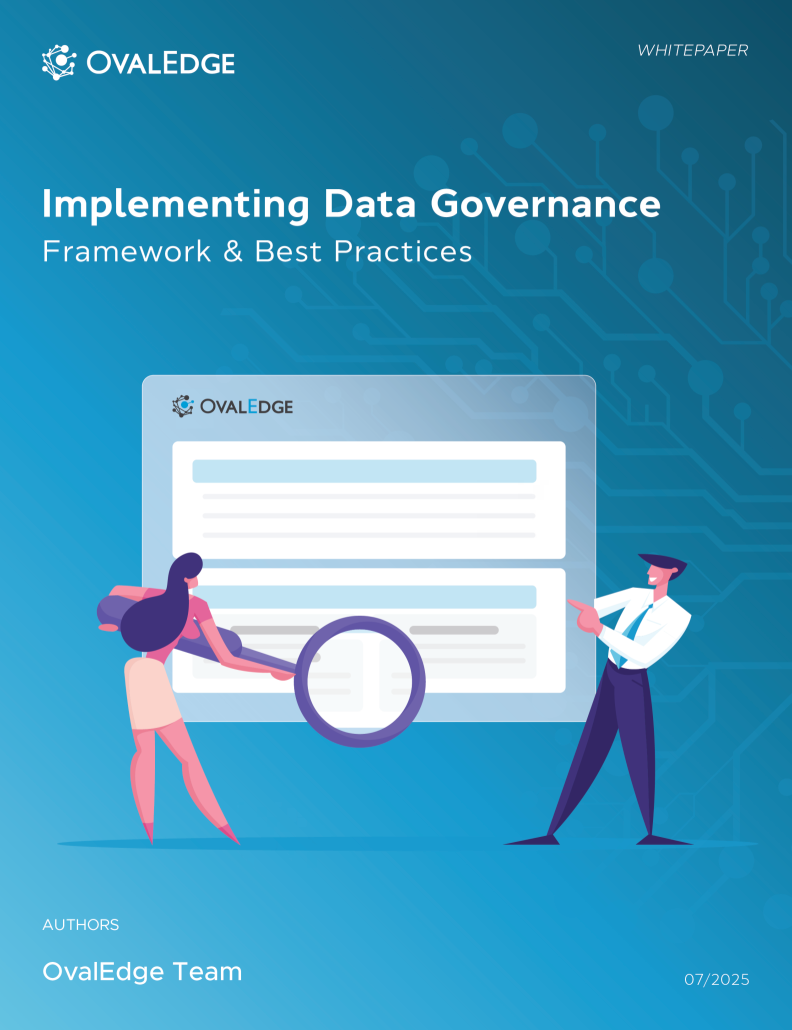Table of Contents
The Four Pillars of Data Governance for Modern Enterprises
Every organization wants to be data-driven, yet most spend more time reconciling reports than interpreting them. Without shared definitions, ownership, and controls, trust collapses before insight begins. A strong governance framework restores confidence by aligning people, policies, and technology around a single version of truth. OvalEdge embeds these principles through automation, quality management, and stewardship workflows, turning data governance from a compliance burden into a driver of consistent, confident decision-making.
Data is supposed to drive better decisions. Yet for many organizations, it does the opposite. Dashboards show conflicting numbers. Reports take days to reconcile. Teams debate whose version of the data is correct rather than discussing what it means. Somewhere between collection and insight, trust gets lost.
The reason isn’t a lack of data. It's the lack of governance. As data grows across systems, departments, and cloud platforms, so do the inconsistencies. Different teams define metrics differently. Privacy regulations tighten while access controls remain unclear.
Data scientists spend more time cleaning than analyzing. The promise of “data-driven decision-making” fades under the weight of disorganization and risk.
Without structure, accountability, and clear rules, data becomes noise, hard to control, and harder to trust. Business leaders can’t make confident decisions, compliance teams face exposure, and IT struggles to balance access with security.
This is where data governance comes in. It is about creating a shared language and framework so data can be trusted, secure, and usable across the organization. In short, data governance turns fragmented information into a foundation for confident, consistent, and compliant decision-making.
What is data governance?
Data governance is the structured management of data to ensure it is accurate, consistent, secure, and used responsibly across an organization. It defines the policies, standards, and roles that guide how data is collected, stored, accessed, and shared.
A strong governance framework establishes accountability through clearly defined ownership and stewardship, ensuring compliance with privacy laws and corporate standards. It balances risk and value by protecting sensitive data while making high-quality information available for decision-making and analytics.
Effective data governance turns data into a reliable business asset that supports transparency, trust, and long-term growth.
Core pillars of data governance
Every strong data governance framework rests on a few fundamental supports that define how information is trusted, secured, and used across the organisation. These pillars are the practical levers that turn governance from policy into performance.
Each one solves a different pain point: from ensuring data is accurate enough to drive confident decisions, to assigning the right people to safeguard and maintain it throughout its lifecycle.
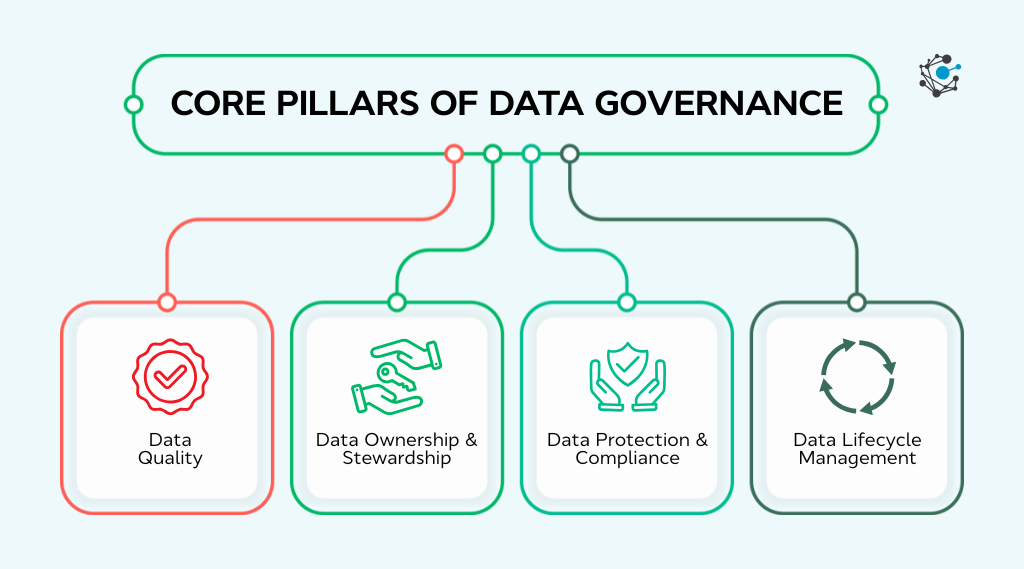
Understanding these pillars allows teams to pinpoint where their governance structure is weakest and focus investment where it will make the greatest impact.
1. Data quality
The pillars of data governance put quality up front because it governs the attributes that decide whether a dataset can be trusted: accuracy, completeness, consistency, timeliness, and relevance.
The pain shows up in everyday work. Marketing teams build audience segments that don’t match finance’s definitions. Operations pulls shipment data with different time zones and truncation rules.
These inconsistencies are often expensive.
According to a 2024 Gartner’s Research on Data Quality, poor data quality costs organizations an average of $12.9 million per year, eroding decision-making, productivity, and customer trust.
People define policies and processes, and technology enforces them, so quality becomes the outcome of clear roles and controls rather than heroic data fixes.
Move from aspiration to practice by formalizing definitions in a business glossary, profiling data as it lands, and measuring quality with a minimal set of KPIs that the business understands.
Define critical data elements and their acceptance criteria in the glossary so disputes are settled by policy, not opinion. Run automated profiling to detect missing values and type mismatches before data is published.
Track a small set of health metrics, such as duplication rate, late-arriving records, and definition adherence, and review them in governance forums where stewards and product owners can act. These practices reflect how leading frameworks operationalize quality instead of treating it as a clean-up project.
Bad data quietly erodes decision-making, costing companies millions each year. OvalEdge helps you fix the problem at the source by embedding automated data quality checks, rule-based anomaly detection, and collaborative issue resolution directly into your governance workflows.
Teams can proactively identify errors, trace them to their root causes through the integrated data catalog, and assign remediation tasks to the right stakeholders, all in one unified platform.
With measurable data quality dashboards and lifecycle tracking, OvalEdge turns quality management from a reactive task into a continuous, automated process that keeps your data and decisions reliable.
2. Data ownership and stewardship
Data quality does not sustain without human accountability. Stewardship assigns a named owner to each dataset, who can approve definitions, negotiate changes, and sign off on release readiness. Stewardship is one of the four core pillars alongside quality, management, and protection. The point is simple: without a decision-maker, quality and privacy controls can’t stick.
Roles and responsibilities must be defined in writing. It recommends identifying owners and stewards per domain and clarifying their authority for definitions, access approvals, lifecycle actions, and issue remediation.
Effective stewardship is more than a name in a spreadsheet. Publish an ownership register that lists each key dataset with its business owner, steward, and custodian. Route schema changes, definition updates, and access requests through workflows that require owner or steward approval.
Review open data issues weekly and hold owners accountable for remediation SLAs. This is how the stewardship pillar translates from an org chart into observable behaviour.
3. Data protection and compliance
Security and privacy are where governance meets law and risk. Breaches, over-exposure, and opaque processing invite fines and erode customer trust.
A well-structured governance framework actively strengthens compliance. According to a 2022 Gartner Study on Data Governance Frameworks and Challenges, 66% of organisations report improved data security, and 52% see fewer compliance breaches after implementing a data governance framework.
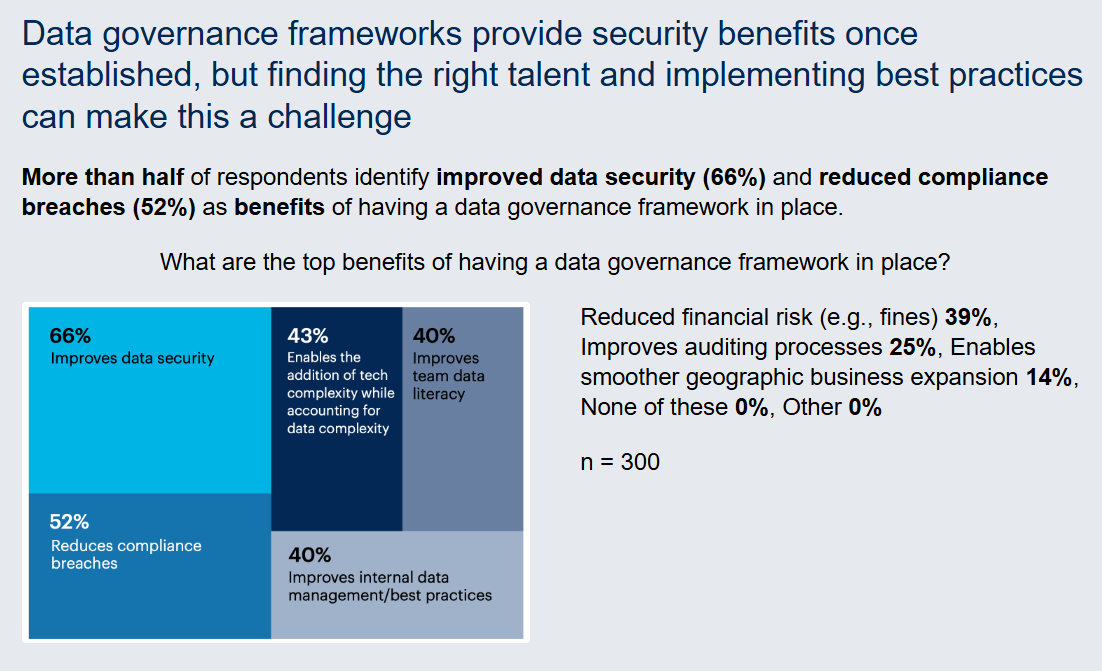
Classify data into sensitivity tiers and bind each tier to default controls such as encryption, masking, and review cadence. Maintain current data flow documentation and lineage so you can evidence processing activities and answer subject requests.
Schedule compliance reviews where owners attest access lists, retention timers, and policy exceptions, and ensure findings feed back into automated controls. These are the mechanics that make the pillar credible under scrutiny.
4. Data lifecycle management
Every dataset has a beginning, middle, and end. Lifecycle governance ensures you only keep what you need, know where it came from, and retire it safely.
Lifecycle governance is inseparable from metadata. Without searchable catalogs, you cannot tell which datasets are authoritative, which are obsolete, or who still depends on them.
Define retention policies per data class and encode them in pipelines and storage so timers drive archival and deletion. Maintain lineage from ingestion to presentation so owners can assess the impact of retiring sources.
Offer storage tiers with clear cost and performance characteristics and require stewards to choose a tier during dataset onboarding. Review “last accessed” and dependency graphs quarterly to retire what is no longer needed. These are the practices that turn the lifecycle pillar into measurable risk and cost reduction.
When these pillars work in harmony, data becomes a reliable business asset rather than a liability waiting to happen.
As we move into the framework implementation stage, the focus shifts from understanding these foundational elements to putting them into motion through policies, roles, and automated systems that embed governance into everyday operations.
Implementing a data governance framework
Building a data governance framework is the turning point where theory becomes operational reality. This phase defines how the pillars of data governance, such as policy, ownership, automation, and monitoring, are enacted across people, processes, and technology.
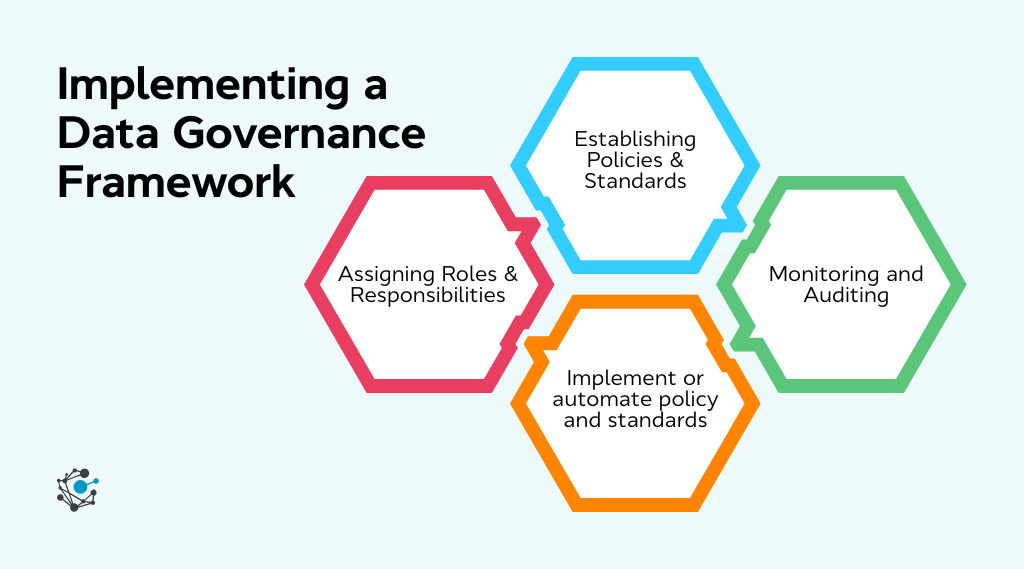
The most successful organisations treat governance not as a static document but as a living system that evolves with business priorities.
1. Establishing policies and standards
Strong policies are the foundation of every governance framework. They clarify how data should be created, classified, stored, accessed, and retired. A well-defined framework specifies key data elements (KDEs) and key quality indicators (KQIs) that align with business objectives such as improving analytics or reducing compliance risk.
A clear data policy eliminates ambiguity: teams know what constitutes “sensitive” data, how long it must be retained, and who can approve access. Creating a business glossary prevents teams from operating with conflicting definitions, which is one of the most common causes of poor data quality and reporting errors.
-
Map out all key business processes and identify which ones rely on governed data.
-
Define KDEs and KQIs for each domain, aligning them to measurable business outcomes.
-
Draft and publish policies for data classification, retention, access, and quality thresholds.
-
Build and maintain a business glossary that provides clear, organisation-wide definitions.
-
Conduct training sessions and communication campaigns to ensure company-wide adoption.
2. Assigning roles and responsibilities
Policies are meaningless without accountability. Governance thrives when every dataset has a clearly identified owner and steward. Defining ownership answers a critical question: “Who makes decisions about this data?”
Roles should be assigned based on expertise and authority. Data owners define strategy and approve major data-related decisions; stewards ensure ongoing quality and compliance; custodians implement the technical controls; and governance councils provide oversight. Clear escalation paths are vital so that issues can be resolved quickly without confusion.
-
Create a data governance council to oversee policies and coordinate decisions across business units.
-
Identify domain-level data owners for key subject areas like finance, sales, and HR.
-
Assign operational data stewards responsible for monitoring data quality and compliance.
-
Document responsibilities, escalation paths, and decision rights in a governance charter.
-
Set up regular review meetings where owners and stewards report data health metrics.
3. Implement or automate policy and standards
Technology operationalises governance by embedding it directly into workflows. Automation reduces human error and ensures consistent compliance across systems.
Automated data governance tools can flag anomalies, enforce access controls, and maintain audit trails without manual intervention. For example, metadata-driven systems can automatically identify PII in a dataset and apply masking policies.
Workflow automation can route access requests or policy exceptions to the right approvers, ensuring timely and consistent handling.
-
Deploy a metadata management or data catalogue solution to centralise data discovery and lineage.
-
Implement automated data quality checks within data pipelines.
-
Configure access control tools to apply role-based permissions automatically.
-
Integrate data classification and masking into ingestion and processing workflows.
-
Establish dashboards that track policy adherence and automatically alert for violations.
4. Monitoring and auditing
Governance cannot function on autopilot. It must be continuously monitored and adjusted. Measurement and monitoring are one of the core governance pillars because they keep the framework aligned with both operational performance and compliance requirements.
Monitoring ensures policies are being followed, data remains high-quality, and governance outcomes are measurable. Regular audits reveal gaps and surface opportunities to improve. Transparent reporting also builds trust with executives, regulators, and customers by demonstrating accountability.
-
Define measurable KPIs for data quality, compliance adherence, and remediation time.
-
Schedule quarterly audits to assess policy compliance and review role effectiveness.
-
Implement dashboards that provide real-time visibility into data quality and issue resolution.
-
Create feedback loops that use audit insights to refine governance policies and automation rules.
-
Present governance performance reports to leadership and align on improvement priorities.
A strong framework empowers people to use it responsibly and effectively, transforming governance from a compliance exercise into a competitive advantage.
Data governance framework best practices
The following best practices strengthen every core pillar, including quality, stewardship, protection, and lifecycle management by embedding accountability, adaptability, and transparency across the enterprise.
1. Engage stakeholders across the organization
One of the biggest misconceptions about governance is that it belongs solely to IT. In reality, it touches every part of the organisation, from legal and compliance teams to business analysts and executives.
Successful governance frameworks balance people, processes, and technology to create a shared sense of ownership. When business users and technical teams collaborate, governance evolves from being a “gatekeeper” function to a business enabler.
In many organisations, fragmentation is the real barrier. Marketing builds its own datasets, finance maintains its own rules, and IT manages its own infrastructure, but no one coordinates these efforts.
This leads to duplication, reporting inconsistencies, and compliance gaps. By involving stakeholders early, organisations can align governance initiatives with actual business priorities and avoid siloed approaches.
-
Identify all key stakeholder groups and create a stakeholder map that clarifies their data interests and dependencies.
-
Conduct workshops or interviews with each group to capture how they define data terms, what metrics matter to them, and what risks they perceive.
-
Form a cross-functional steering committee that includes business, IT, and compliance representatives to ensure decisions are reviewed collaboratively.
-
Establish a shared communication channel (such as a data governance portal or Slack channel) where stakeholders can report issues or suggest improvements.
2. Continuously evaluate and improve data governance practices
Data volumes grow, technologies shift to the cloud, and new privacy laws reshape compliance obligations. Without periodic evaluation, even well-designed frameworks risk becoming obsolete.
Many organisations make the mistake of “setting and forgetting” their governance models, only to discover years later that policies no longer align with business realities. Continuous improvement ensures that governance frameworks adapt to regulatory changes, AI integration, and new data platforms while still maintaining consistency and compliance.
-
Use a recognised data governance maturity model to assess the current state of governance processes, tools, and culture.
-
Conduct structured reviews at least annually to evaluate whether policies, standards, and role definitions still meet organisational goals.
-
Document lessons learned from incidents such as data breaches, reporting delays, or analytics inaccuracies, and update policies accordingly.
3. Establish clear data ownership and accountability
Data ownership remains one of the most critical yet frequently neglected governance pillars. Without defined owners and stewards, accountability erodes, and decision-making slows down.
Stewardship and accountability are central to effective data governance because they ensure that every data asset has someone responsible for its quality, compliance, and usability.
A common problem arises when teams cannot determine who approves data changes or resolves inconsistencies. This leads to ungoverned data growth, conflicting reports, and compliance risks.
Defining ownership at both the strategic (data owner) and operational (data steward) levels ensures that governance activities are coordinated, measurable, and enforceable.
-
Assign data ownership at the domain level (for example, Sales, HR, Finance) and clearly document each owner’s authority.
-
Appoint data stewards who are responsible for day-to-day management tasks like metadata maintenance, quality monitoring, and policy enforcement.
-
Publish and maintain a central inventory of data assets that lists their respective owners, stewards, and custodians.
-
Embed governance accountability into job descriptions, key performance indicators (KPIs), and annual objectives to ensure ongoing responsibility.
-
Develop escalation procedures for unresolved data quality or compliance issues to maintain accountability throughout the organisation.
4. Maintain data transparency and accessibility
True governance promotes data transparency, not restriction. The goal is to ensure that the right people have access to the right data with the right controls.
The challenge lies in balancing openness with security. Too many restrictions frustrate users and encourage “shadow data” practices, while too much freedom risks data exposure and inconsistency.
Transparency also builds trust by giving users visibility into data lineage, definitions, and ownership, helping them understand where data comes from and how it should be used.
-
Implement a centralised, searchable data catalogue that documents metadata, lineage, classifications, and usage guidelines.
-
Apply role-based access controls (RBAC) to enforce permissions without blocking legitimate business use.
-
Document data flows, policies, and standards in plain language so users understand how and why data governance exists.
-
Conduct regular access reviews to ensure that permissions remain appropriate as roles evolve.
Governance becomes a shared organisational discipline, one that protects data integrity while empowering people to use it confidently for innovation and decision-making.
Conclusion
Most organisations don’t fail at data governance because of a lack of intention. They fail because of inconsistency. Policies are written but not followed, ownership is assigned but not enforced, and quality controls exist only after problems arise.
According to Gartner's 2024 Data Quality Insights, the major part of this inconsistency stems from a lack of ownership. While business leaders agree that data quality matters, many don’t see it as their responsibility or fully grasp how the data in their domain impacts enterprise-wide outcomes.
Yet, data quality is fundamentally a business discipline; how teams enter, use, and manage data determines its reliability. Without shared accountability and collaboration between business and technical stakeholders, even the best-designed frameworks fall short of their potential.
The real challenge is operationalising governance across silos, systems, and human behaviour.
To overcome this, treat governance as a living discipline, not a project. Embed it into the rhythms of how teams plan, build, and analyse data. Use automation to make compliance effortless and transparency non-negotiable.
Align governance goals with business outcomes, whether that’s faster analytics, fewer regulatory incidents, or improved customer trust, so that every policy has a measurable purpose.
When the pillars of data governance (quality, stewardship, protection, and lifecycle management) work in concert, they don’t just reduce risk. They create resilience. They ensure that data, once an underused liability, becomes a dependable, value-generating asset that fuels smarter decisions and sustained competitive growth.
Struggling to keep your data organized and compliant?
OvalEdge makes data governance simple. Automate quality checks, ensure compliance, and give every team access to trusted, usable data. Fast to set up and easy to use.
Book a demo today and see how OvalEdge helps you govern your data with confidence.
FAQs
1. What are the pillars of data governance?
The core pillars of data governance are data quality, data ownership and stewardship, data protection and compliance, and data lifecycle management. Together, they ensure data is accurate, secure, and used responsibly across its lifecycle. These pillars establish trust in information, define clear accountability, and align governance with business objectives.
2. How do I implement a data governance framework?
Implementing a data governance framework starts with defining policies and standards that align with business goals. Assign data owners, stewards, and custodians to ensure accountability. Next, automate governance rules across systems to enforce access, quality, and compliance controls. Finally, monitor and audit regularly to measure adherence and continuously improve governance maturity.
3. Why is data governance important?
Data governance ensures data assets remain accurate, secure, and accessible, driving informed decision-making and reducing risk. It prevents data silos, enhances compliance with regulations like GDPR and HIPAA, and improves confidence in analytics and reporting. Strong governance transforms data into a trusted business asset that delivers measurable value.
4. What is data stewardship?
Data stewardship is the practice of assigning operational accountability for data assets. Data stewards manage data quality, enforce governance policies, and act as bridges between business and IT teams. They ensure that datasets are correctly defined, maintained, and used in alignment with organizational standards.
5. How do you ensure data compliance?
Ensuring data compliance involves classifying data by sensitivity, applying access controls, encryption, and documenting data flows. Regular audits and retention policies help demonstrate compliance with privacy frameworks like GDPR, CCPA, and HIPAA. Governance tools and automation further strengthen compliance by enforcing these controls consistently across systems.
6. How can organizations improve their data governance maturity?
Organizations can improve governance maturity by performing regular evaluations, adopting a recognized maturity model, and learning from incidents such as data breaches or reporting errors. Continuous improvement keeps governance aligned with emerging technologies, regulations, and business needs.
OvalEdge recognized as a leader in data governance solutions
.png?width=1081&height=173&name=Forrester%201%20(1).png)
“Reference customers have repeatedly mentioned the great customer service they receive along with the support for their custom requirements, facilitating time to value. OvalEdge fits well with organizations prioritizing business user empowerment within their data governance strategy.”
.png?width=1081&height=241&name=KC%20-%20Logo%201%20(1).png)
“Reference customers have repeatedly mentioned the great customer service they receive along with the support for their custom requirements, facilitating time to value. OvalEdge fits well with organizations prioritizing business user empowerment within their data governance strategy.”
Gartner, Magic Quadrant for Data and Analytics Governance Platforms, January 2025
Gartner does not endorse any vendor, product or service depicted in its research publications, and does not advise technology users to select only those vendors with the highest ratings or other designation. Gartner research publications consist of the opinions of Gartner’s research organization and should not be construed as statements of fact. Gartner disclaims all warranties, expressed or implied, with respect to this research, including any warranties of merchantability or fitness for a particular purpose.
GARTNER and MAGIC QUADRANT are registered trademarks of Gartner, Inc. and/or its affiliates in the U.S. and internationally and are used herein with permission. All rights reserved.


.png)
.webp)
